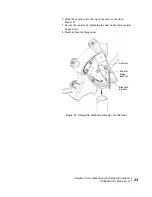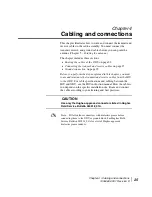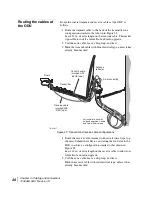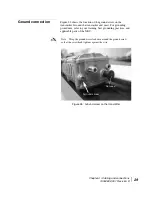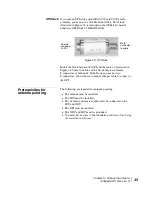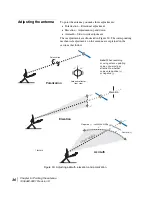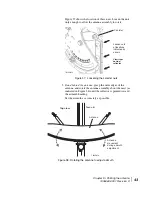
Chapter 5 • Pointing the antenna
1036469-0001 Revision D
33
Peaking the signal
Correct antenna alignment is critical to the operation of the
system. When the antenna is pointed directly at the satellite, it
receives a strong signal. If it is not pointed properly, the signal
may be weak, and errors may result during data transfers.
Antenna pointing is accomplished by first
receive pointing
the
antenna and then
isolating the transmit signal
. Receive pointing
adjusts the antenna to obtain the best receive signal. Isolating the
transmit signal fine tunes the antenna alignment for the strongest
possible signal received by the Hughes Network Operations
Center (NOC). Both processes are explained later in this chapter.
To point the antenna, you go through cycles of making small
adjustments to the antenna until you are satisfied you cannot get a
stronger satellite signal. When you have achieved the strongest
possible signal, you have
peaked
the signal.
You may achieve the strongest signal strength after just a few
adjustments, or you may find that several adjustments are needed.
By obtaining the strongest possible signal you ensure that the
terminal can use all the system’s capacity.
Personnel requirements
One person can point the antenna if an outdoor pointing interface
(OPI) is used (as explained in
Outdoor pointing interface
on
page 34). Otherwise, pointing is usually a two-person task. One
person aims and adjusts the antenna while the other watches the
signal strength display on the computer and relays the readings to
the person at the antenna. A portable telephone or walkie-talkie is
helpful for this.
Pointing parameters
Prior to antenna pointing, you use the installation software to
enter parameters such as longitude, latitude, and polarization
angle. Or you can enter the local ZIP code and let the software
calculate these values.
Summary of Contents for AN6-074S
Page 8: ... Important safety information viii 1036469 0001 Revision D ...
Page 11: ... Contents 1036469 0001 Revision D xi Acronyms and abbreviations 49 Index 51 ...
Page 12: ... Contents xii 1036469 0001 Revision D ...
Page 16: ... Tables xvi 1036469 0001 Revision D ...
Page 18: ... About this document xviii 1036469 0001 Revision D ...
Page 28: ...Chapter 2 Antenna components tools and materials 10 1036469 0001 Revision D ...
Page 48: ...Chapter 4 Cabling and connections 30 1036469 0001 Revision D ...
Page 68: ... Acronyms and abbreviations 50 1036469 0001 Revision D ...





